COVID-driven loss of jobs and employment income will cause the number of homeless workers to increase each year through 2023. Without large-scale, government employment programs the Pandemic Recession is projected to cause twice as much homelessness as the 2008 Great Recession.
The Economic Roundtable used data from the 2008 Great Recession to estimate the linkage between job loss and homelessness and forecast the amount and type of pandemic-driven homelessness in Los Angeles, California and the United States.
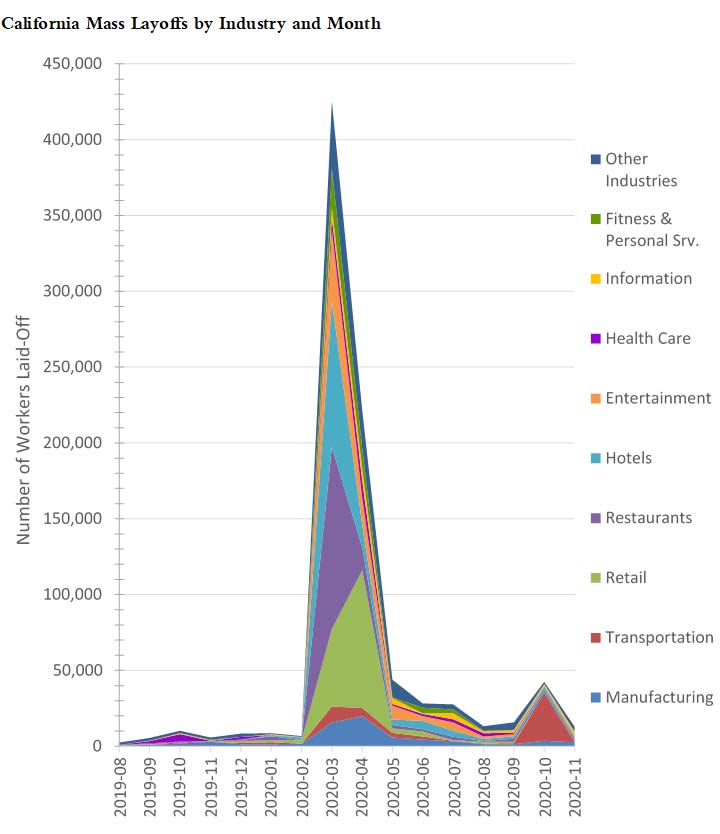 Ten percent of recession-caused unemployment in Los Angeles from the 2008 Great Recession was linked to subsequent homelessness of some type among working-age adults. Those lacking shelter include: homeless on the streets, shelter residents and couch surfers. Homelessness lagged unemployment at the beginning of the 2008 recession but continued to grow rapidly for three years after the official end of the recession.
Ten percent of recession-caused unemployment in Los Angeles from the 2008 Great Recession was linked to subsequent homelessness of some type among working-age adults. Those lacking shelter include: homeless on the streets, shelter residents and couch surfers. Homelessness lagged unemployment at the beginning of the 2008 recession but continued to grow rapidly for three years after the official end of the recession.
Disconnection from work is a degenerative dynamic – less work, less earnings, less stable living conditions, and further disconnection from work. It is not total job loss but rather loss at the margins of the labor market that is the primary cause of economically-driven homelessness.
The epicenter of job destruction and unemployment in the Pandemic Recession lies in restaurants, retail stores, restaurants and bars, personal services, social services, and education. These are the largest employers of low-wage workers, who often are precariously housed even in a growing economy.
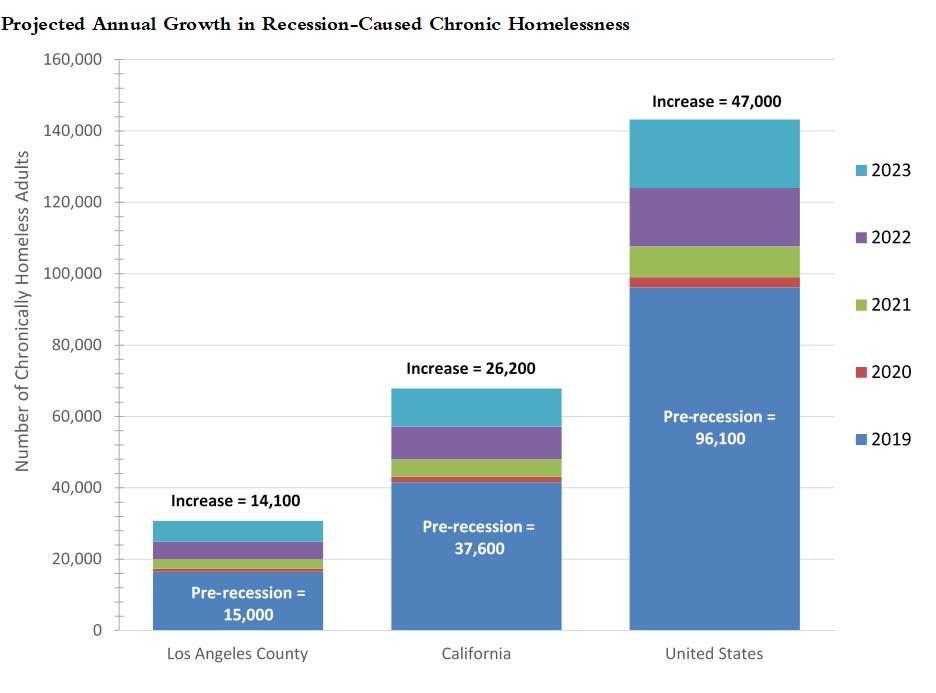 Over the next four years the current Pandemic Recession is projected to cause chronic homelessness to increase 49 percent in the United States, 68 percent in California and 86 percent in Los Angeles County.
Over the next four years the current Pandemic Recession is projected to cause chronic homelessness to increase 49 percent in the United States, 68 percent in California and 86 percent in Los Angeles County.
Homelessness among working-age adults caused by the current recession is projected to peak in 2023, adding 603,000 working-age adults to those already without a place of their own to sleep in the United States. California is projected to be home to 131,400 of those additional homeless adults, with 52,300 in Los Angeles County swelling current homeless numbers.
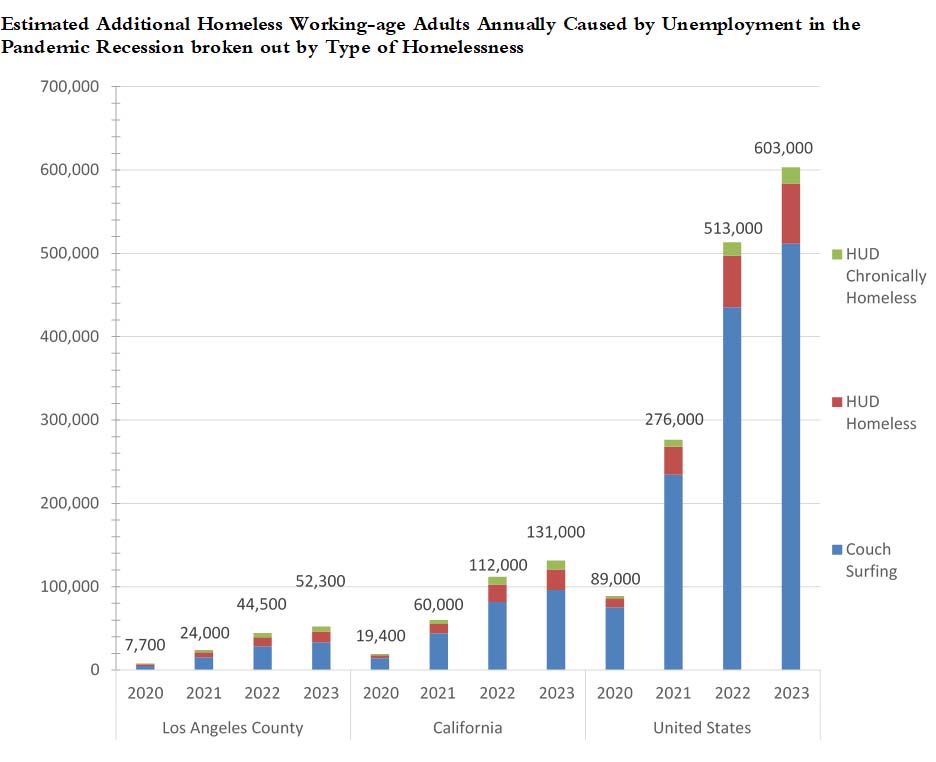 Most homelessness from the Pandemic Recession is projected to be in the form of couch surfing – 85 percent in the United States, 73 percent in California and 64 percent in Los Angeles County. These different rates result from different propensities to produce homelessness and different mixes in the types of homelessness in different parts of the United States.
Most homelessness from the Pandemic Recession is projected to be in the form of couch surfing – 85 percent in the United States, 73 percent in California and 64 percent in Los Angeles County. These different rates result from different propensities to produce homelessness and different mixes in the types of homelessness in different parts of the United States.
People are likely to fend off homelessness as long as possible by foregoing other expenses, relinquishing assets and going into debt in order to remain housed. However, without money to pay for rent or the help of family and friends, it is likely that individuals will be evicted and lack a place of their own to sleep. Thus the total number of homeless will continue to grow even after the recession ends.
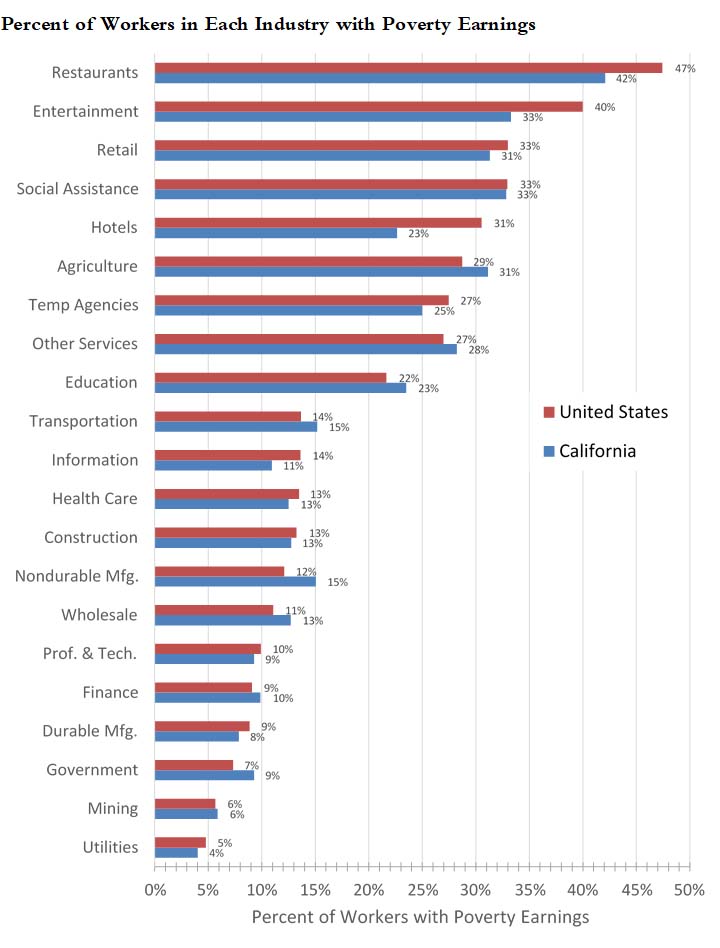 The one-fifth of American workers who face the highest risk of long-term unemployment and homelessness earn less than the poverty threshold. Most hold part-time, low-wage jobs, including some workers who are still working but homeless.
The one-fifth of American workers who face the highest risk of long-term unemployment and homelessness earn less than the poverty threshold. Most hold part-time, low-wage jobs, including some workers who are still working but homeless.
Workers with the greatest risk of long-term unemployment and homelessness include African Americans, Latinos, young adults 18 to 24 years of age, women, and those with less than a four-year college degree.
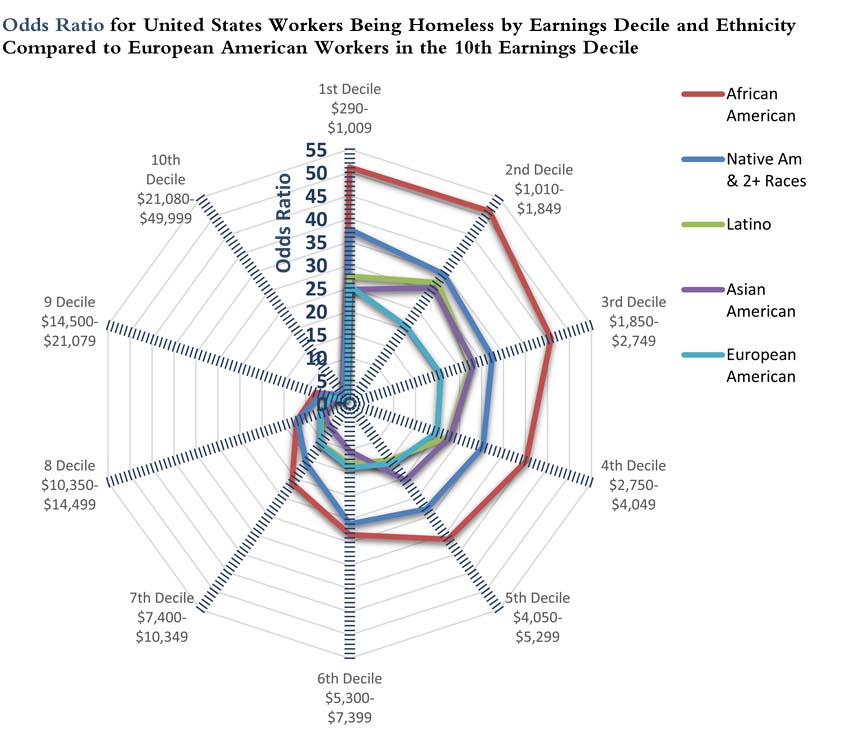 The odds of homelessness at any income level are twice as high for Latinos as they are for European Americans, and three times higher for African Americans. Because incomes skew lower for African Americans and Latinos than for European Americans, their risks are compounded. This reflects social hazards experienced by African Americans and Latinos including bias, discrimination and barriers in employment, housing, education, and the justice system.
The odds of homelessness at any income level are twice as high for Latinos as they are for European Americans, and three times higher for African Americans. Because incomes skew lower for African Americans and Latinos than for European Americans, their risks are compounded. This reflects social hazards experienced by African Americans and Latinos including bias, discrimination and barriers in employment, housing, education, and the justice system.
Swift and massive government intervention is needed to create jobs and provide earned income for unemployed workers who face the possibility of homelessness. Universities, social services agencies and churches that are employing homeless workers but not lifting them out of poverty to provide higher wages and more hours of work.
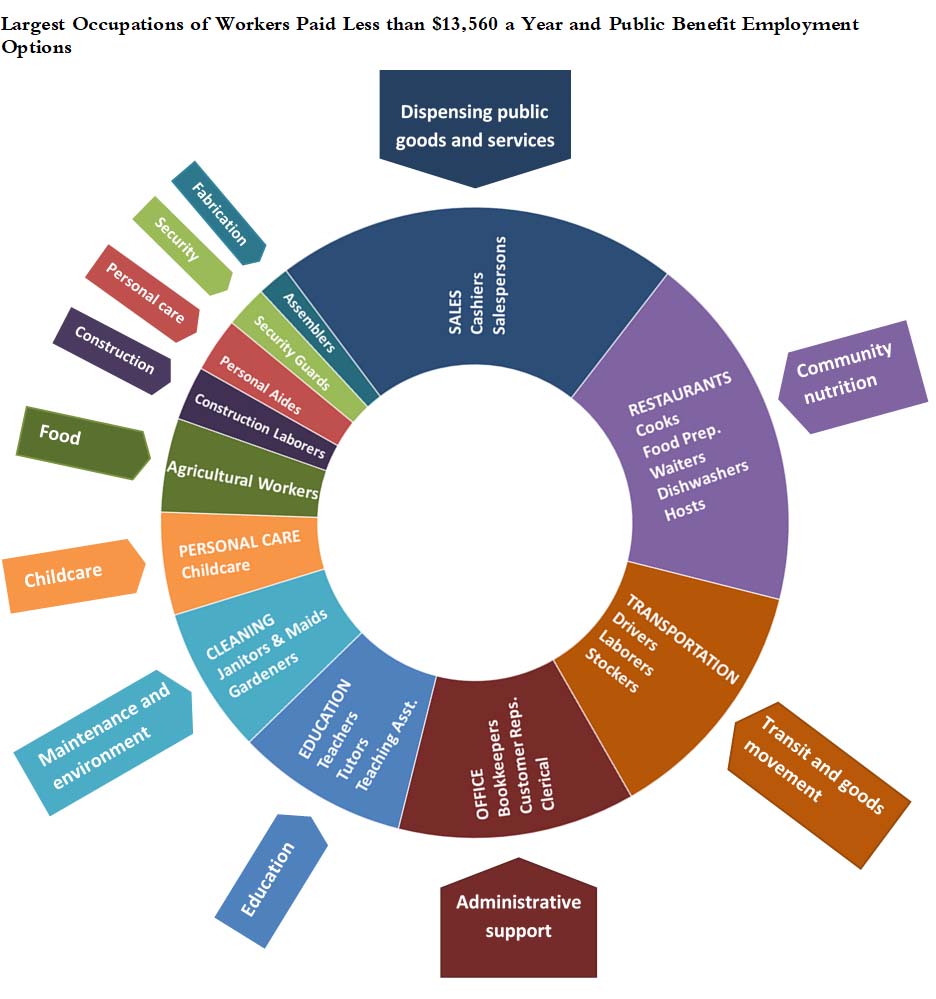 The skills, energy and aspirations of at-risk workers can be employed for public benefit. Employment programs should prioritize helping workers who are at risk of losing their housing and those who have no place of their own to sleep. They should use workers’ existing skills and also support permanent economic progress by providing education and training to upgrade skills.
The skills, energy and aspirations of at-risk workers can be employed for public benefit. Employment programs should prioritize helping workers who are at risk of losing their housing and those who have no place of their own to sleep. They should use workers’ existing skills and also support permanent economic progress by providing education and training to upgrade skills.
Housing prices and rents have grown faster than incomes, so housing costs consume an increasing portion of workers’ budgets. Unpaid rent could double by early 2021, straining landlord budgets and increasing pressure to evict delinquent tenants.
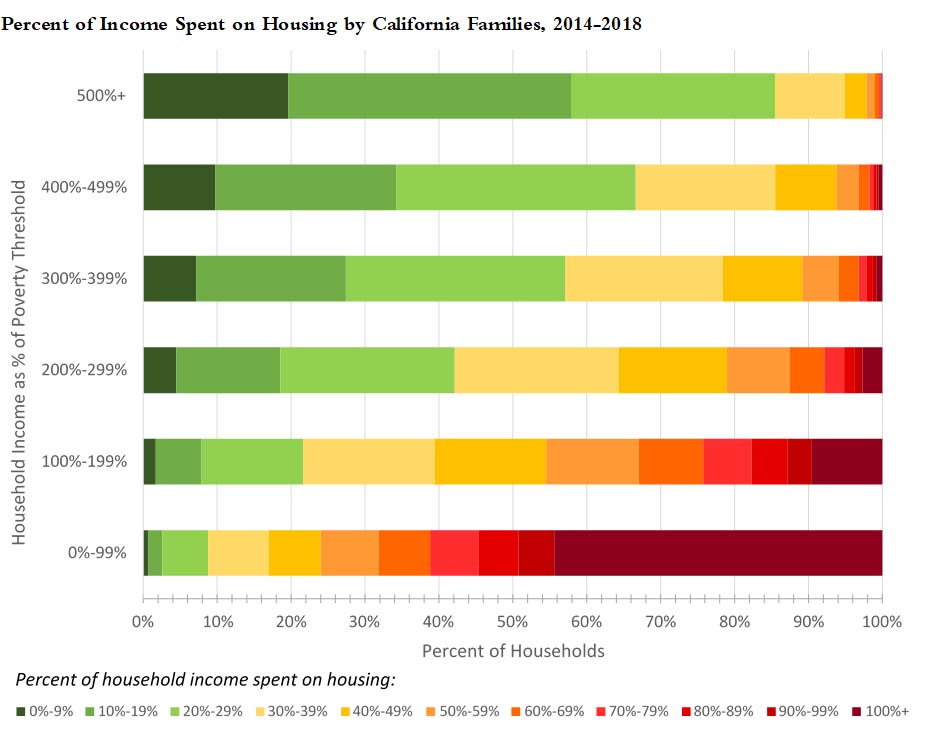 Housing is hard to afford for most families in poverty. Over half of U.S. families who are in poverty pay over half of their income for housing. In California almost three-quarters of poverty families are this cost-burdened for housing.
Housing is hard to afford for most families in poverty. Over half of U.S. families who are in poverty pay over half of their income for housing. In California almost three-quarters of poverty families are this cost-burdened for housing.
The most important determinant of pending eviction or foreclosure is recent household job loss. Half of Africans Americans and Latinos in the U.S. express no confidence or only slight confidence that they can pay for housing next month. One-third of African-American and Latino renters are behind on rent and expecting eviction.
 Unpaid rent could double by early 2021, straining landlord budgets and increasing pressure to evict delinquent tenants. Most Americans want to meet their financial obligations. If public programs cover their income shortfall, they will continue to pay for housing. Policymakers should give financial incentives to landlords and lenders to defer rental and mortgage payments and forgive payments that were missed during the pandemic.
Unpaid rent could double by early 2021, straining landlord budgets and increasing pressure to evict delinquent tenants. Most Americans want to meet their financial obligations. If public programs cover their income shortfall, they will continue to pay for housing. Policymakers should give financial incentives to landlords and lenders to defer rental and mortgage payments and forgive payments that were missed during the pandemic.
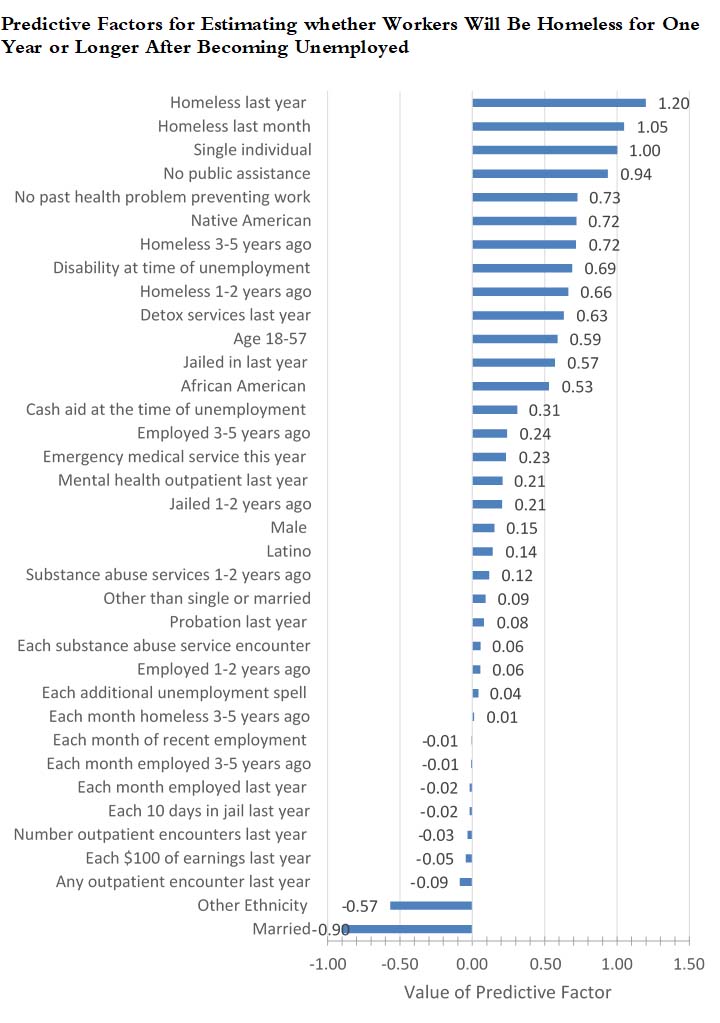 The risks that lead from unemployment to homelessness are not stand-alone threats. They include all of the social and economic ingredients of a worker’s life layered on top of each other, some as safeguards and others as vulnerabilities. Poverty employment, unemployment, ethnicity, isolation, personal crises, destitution, and homelessness are mutually reinforcing.
The risks that lead from unemployment to homelessness are not stand-alone threats. They include all of the social and economic ingredients of a worker’s life layered on top of each other, some as safeguards and others as vulnerabilities. Poverty employment, unemployment, ethnicity, isolation, personal crises, destitution, and homelessness are mutually reinforcing.
To increase the supply of affordable housing the federal government should fully fund rent subsidies for low-income families and increase subsidies for building affordable housing. State and local governments should establish affordable housing trust funds and use some of this money to buy empty commercial buildings and convert them to affordable housing.
The solution of employment costs less than the problem of homelessness. Individuals who become persistently homeless use more public services and have higher public costs than their peers who do not become homeless. These costs are ongoing and increase as individuals become older. Persistently homeless workers in Los Angeles typically have public costs of $13,700 a year for benefits and services received from local government.
One promising pilot effort, the Realization Project, demonstrates a new employment model for homeless workers. The project addresses chronic homelessness as a problem of racial injustice as well as of inadequate income. Participating community college students, who are likely to be persistently homeless, are provided comprehensive life skill services, college-level work-skill development and jobs.
Press Coverage
A progressive real estate transfer tax would help the city tackle homelessness
By Matt Martin and Maria Hadden, Chicago Tribune (October 7, 2022)
Homeless Crisis Will Get Worse, But There Is A Path Forward
By Dick Platkin, City Watch (August 4, 2022)
Tax the Rich, House the Homeless
By Sam Pizzigati, Inequality (June 30, 2022)
Understanding America’s homelessness crisis
By The Week (May 1, 2022)
Overheated housing market’s recent casualty — mortgage companies. But wider impact looms.
By Sougata Mukherjee, The Business Journals (April 14, 2022)
Is the real estate bubble growing in the US?
By Maite Knorr-Evans, AS (April 10, 2022)
Are Unhoused People Likely To Benefit From Biden’s Job Growth Plans?
By Ethan Ward, LAist (March 4, 2022)
Job training and placement: Crucial to helping LA homeless
By Jennifer Hark Dietz and Erika Hartman, Capitol Weekly (February 9, 2022)
Homelessness is on the rise in Wicomico. Two housing solutions on horizon
By Delmarva Daily Times (February 3, 2022)
Greater Los Angeles Homeless Count resumes in Westwood, seeks volunteers
By Kurtis Yan, Daily Bruin (January 6, 2022)
Homelessness
By John Oliver, Last Week Tonight (October 31, 2021)
John Oliver critiques Bay Area in latest segment on homelessness crisis
By Amanda Bartlett, SFGATE (November 1, 2021)
Homelessness is biggest issue facing Los Angeles, residents say, and it’s projected to get worse
By Tami Abdollah, USA Today (October 7, 2021)
Over One Million Angelenos Face Eviction as Moratorium Expires
By Alice Sun, The Epoch Times (September 24, 2021)
Giving new life to deserted parking garages
By Wes Guckert, Smart Cities (July 7, 2021)
Los Angeles cracks down on homeless tent cities: City Council to ban camping near schools and parks – and people can’t take over sidewalks – as new pictures reveal scale of the crisis
By Gina Martinez, Daily Mail (July 1, 2021)
Los Angeles City Council votes on substitute motion restricting homeless encampments public areas
By Isabella Khademhosseini, Texas News Today (July 1, 2021)
Fires in LA, a Tiny Solution for Big Problem
By Paige Olexa, Scribnerr (June 26, 2021)
The Fight Against Homelessness in California Is Just Beginning
By Sasha Abramsky, The Nation (June 25, 2021)
After 4 years and millions spend, Tacoma’s homeless crisis persists. So what now?
By Drew Perine , Tacoma News Tribune (June 10, 2021)
The COVID-19 emergency is far from over for vulnerable renters
By David L. Ulin, Los Angeles Times (June 4, 2021)
L.A. Unemployment Rate Is Nearly Double National Number As Homelessness, Housing Prices Hit Record Highs
By Tom Tapp, Deadline (May 25, 2021)
Los Angeles Unemployment Rate Is Nearly Double The National Number
By Sarah Williams, Talesbuzz (May 25, 2021)
Venice’s world-famous beach and boardwalk have been ‘crippled’ by HUGE increase in robberies and a homeless camp has resulted in spikes in shootings, arson and even DOG attacks, say locals
By Bevan Hurley and Holden Walter-Warner, Daily Mail (May 8, 2021)
How The Pandemic Forced A Youth Homeless Shelter In Colorado To Adapt
By Stephanie Serrano, KUNM Mountain West News Bureau, April 29, 2021
Dr. Drew Pinsky Responds to Advocates Who Opposed Nomination to LA Homeless Commission
By Carly Mayberry, Newsweek (April 20, 2021)
Republican Withdraws Dr. Drew’s Nomination To Los Angeles Homeless Commission After Progressive Pushback
By Jeffrey Cawood, Daily Wire (April 20, 2021)
Is Los Angeles’ Sweep of a Homeless Encampment the Wave of the Future?
By Jack Ross, Capital and Main (April 16, 2021)
Etats-Unis : 5 milliards de dollars d’aides pour le logement et les sans-abri
By Isabelle Hanne, Libération (April 9, 2021)
Cuyahoga County Is Using Alternative Methods For Housing The Homeless
By Marcia Pledger, Cleveland Magazine (April 8, 2021)
‘I’m not sure where we go from here’: pandemic fuels rise in US homelessness
By Michael Sainato, The Guardian (March 25, 2021)
The American Rescue Plan needs a long-term plan for homeless families
By Larry Seamans, Kate Barrand and Danielle Ferrier, Boston Globe (April 12, 2021)
Social workers need assistance as they help rebuild a post-COVID world
By Angelo McClain, The Columbus Dispatch (April 5, 2021)
California homeless crisis explodes, considered ‘catastrophic’ by experts
By Christina Aguayo, News Net (April 1, 2021)
Delray Beach company challenges corporate culture amid a ‘pandemic recession’
By Arthur Mondale, WPTV 5 West Palm Beach (April 6, 2021)
Pandemic: American Dream to Nightmare for Growing Homeless Population
St Kitts & Nevis Observer (March 29, 2021)
Mariachi Community Counting On COVID Vaccine To Save Livelihood
Monrovia Weekly (March 24, 2021)
COVID-19 homelessness is a public health problem — it’s about to get worse
By Lyndon Haviland, The Hill (March 22, 2021)
Girl Scout troop gives girls without homes moments of normalcy
By Alexa Liacko, Fox 13 Salt Lake City (March 19, 2021)
Inside the COVID-19 recession, one of the most unequal in modern history
By Scott Pelley, 60 Minutes CBS News (March 7, 2021)
Corona raakt de latinogemeenschap in Los Angeles ongekend hard
By Mari Meyer, Trouw (March 4, 2021)
Identifying homeless eligible for COVID-19 vaccinations
By Sylvester Brown, The St. Louis American (March 1, 2021)
Homeless People Losing Their Lives in Excess – Homeless Deaths in Los Angeles Rose by More than 30% in 2020
By Jessica Goodheart, LA Progressive (February 7, 2021)
Mapping Los Angeles’s Unequal Covid-19 Surge
By Jill Cowan, New York Times (February 1, 2021)
Citing increases in homeless, Norwalk may ask federal judge for right to enforce anti-camping laws
By Mike Sprague, Whittier Daily News (February 18, 2021)
How an Employment Social Enterprise Can Help Address Homelessness
By Mark Loranger, C-Suite Quarterly (February 9, 2021)
Aus der Traum
By Michaela Haas, Zeit (February 5, 2021)
In L.A., the Virus Is Pummeling Those Who Can Least Afford to Fall Ill
By Jill Cowan and Matthew Bloch, New York Times (January 29, 2021)
COVID-19 could devastate the homeless. How will America pick up the pieces?
Suzette Hackney, USA Today (January 30, 2021)
LA housing officials paid more than Cabinet secretaries as city sees spike in homeless population
By Carly Ortiz-Lytle, Washington Examiner (January 31, 2021)
COVID: Destroying Jobs and Increasing Homelessness
By Mike Bonin, What’s Next, Los Angeles? (January 24, 2021)
COVID-19 job losses will worsen L.A. homelessness by 2023, new report says
By Doug Smith, Los Angeles Times (January 12, 2021)
Biden has big plans for homelessness — but will it help Seattle?
By Scott Greenstone, The Seattle Times (January 21, 2021)
How much will homelessness rise? Grim study shows possible ‘impact of doing nothing,’ researchers say
By Scott Greenstone, Seattle Times (January 12, 2021)
Study: LA County’s low-wage, part-time workers will be hardest hit by homelessness, COVID recession
By Elizabeth Chou, Los Angeles Daily News (January 12, 2021)
Stories of Crows and People – If we know how we dig holes in the world, maybe we won’t fall in so often
By Ira Rabois, The Good Men Project (February 7, 2021)
COVID-19 could devastate the homeless. How will America pick up the pieces?
Suzette Hackney, AZCentral (February 5, 2021)
Morning Brief: Another Attempt To House The Homeless Follows Years Of False Starts
The LAist (February 4, 2021)
Bedrosian Center: Economic Roundtable’s Locked Out Report – Full Video and Highlights
By Aubrey L. Hicks, USC Bedrosian Center (January 22, 2021)
Pandemic job losses could fuel a rise in homelessness for years
By Camille Squires, City Monitor (January 22, 2021)
LA’s New Housing Element Another Big Bamboozle?
By Dick Platkin, LA Progressive (January 22, 2021)
Big Bamboozle #2 – How LA Hopes to Extend a Real Estate Boom and Hold off its Eventual Bust
By Dick Platkin, City Watch LA (January 21, 2021)
Pandemic-Driven Homelessness Will Double That Of The Great Recession, Analysis Finds
By Stephanie Serrano, Wyoming Public Radio (January 22, 2021)
聯邦對費城的裁決,或對西雅圖開設「毒品站」不利?
Seattle Chinese Times (January 25, 2021)
Shoot Me Up, Scotty… Part Four
by Bill Hudson, Pagosa Daily Post (January 21, 2021)
Report: Pandemic could double number of homeless individuals nationally
By Gee and Ursula Show, My Northwest (January 21, 2021)
LA’s New Housing Element Another Big Bamboozle?
By Dick Platkin, LA Progressive (January 19, 2021)
New Study: Dramatic Rise in Homelessness Expected Due to Pandemic Recession, L.A. County is projected to see an 86% increase in chronic homelessness by 2023
By Jessica Goodheart, Capital & Main (January 12, 2021)
‘Catastrophic:’ Chronic homelessness in LA County expected to skyrocket by 86% in next 4 years
By Rob Hayes, ABC7 Eyewitness News (January 12, 2021)
COVID-19 job losses will worsen L.A. homelessness by 2023, report finds
By KTLA 5 News (January 12, 2021)
COVID-19 will cause twice as much homelessness as Great Recession, researchers say
By Jacob Passy, MarketWatch (January 13, 2021)
Pandemic could cause twice as much homelessness as the Great Recession
By Samantha Fields, Marketplace (January 14, 2021)
The pandemic recession could cause an enormous spike in homelessness
By Jessica Goodheart, Fast Company (January 14, 2021)
LA Councilman Proposes Construction Of 25,000 Housing Units To Ease Homelessness
By KCAL 9 CBS Los Angeles (January 12, 2021)
¿Cuánto aumentará la población sin techo?
By Scott Greenstone, Chicago Tribune (January 13, 2021)
Californians Tell Gov. Newsom: Renters and Landlords Need $5 Billion – Statewide Ad Campaign Launched
By Business Wire (January 13, 2021)
Bonin, Raman Motion To Replace Encampment Cleanups – Two LA City Council members introduced a motion Tuesday to stop the city’s mandatory cleanups of homeless encampments and replace them
By Nicole Charky, Patch (January 12, 2021)
For Renters, the COVID-19 Pandemic May Be A Long-Term Economic Disaster
By Patrick Range McDonald, CityWatch (January 14, 2021)
Job losses from COVID-19 are expected to lead to an increase in homelessness in Los Angeles
By Steven Sharp, Urbanize Los Angeles (January 13, 2021)
Utah’s COVID-19 Positivity Rate, Pandemic Homelessness & Healthcare Worker Stress
By Stephanie Serrano, KURN NPR Utah (January 12, 2021)
COVID-19 will cause twice as much homelessness as Great Recession, researchers say
By WMRE Staff, Wealth Management.com (January 13, 2021)
COVID Job Losses To Worsen L.A. Homelessness By 2023
California Healthline (January 12, 2021)
How much will homelessness rise? Grim study shows possible ‘impact of doing nothing,’ researchers say
By Scott Greenstone, Rome News-Tribune (January 13, 2021)
North Texas Man Gives Hundreds of Sleeping Bags to People Experiencing Homelessness
By Brian Scott, Spectrum News 1, Dallas Texas (January 19, 2021)
Is there a Better Way to Collect Data on Homelessness?
By Max Reyes and Kriston Capps, Bloomberg CityLab (January 22, 2021)













